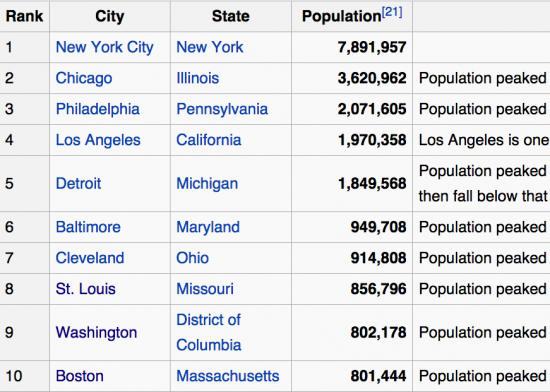Here are the 10 biggest cities in America in 1950, when most hit their peak:
Tyler Cowen recently linked to an article that has lots of interesting information about Baltimore’s decline.
As a result of Baltimore’s multiple social, economic, and educational problems, the city’s population has declined from 939,000 in 1960 to just622,000 today. In silent, gloomy testament to this prolonged exodus, some47,000 abandoned houses and 16,000 vacant buildings now stand like pulled teeth in Baltimore’s urban landscape.
I thought it might be useful to put that decline into some sort of perspective. Thus I’ll list the population of these same 10 cities in 2013 (many are no longer top 10) as well as the ratio to their 1950 populations. Then I’ll suggest 5 groupings:
New York 8405k 106.5%
Chicago 2719k 75.1%
LA 3884k 197.2%
Philly 1553k 75.0%
Detroit 689k 37.2%
Baltimore 622k 65.5%
Cleveland 390k 42.6%
St Louis 318k 37.1%
Washington 646k 80.5%
Boston 645k 80.5%
I see 5 groupings:
Cities hitting record population, and still growing. (NYC, LA)
Cities down substantially, but growing really fast since 2010 (Boston & DC, which were both smaller than Baltimore as recently as 2010.)
Cities down substantially and growing modestly (Chicago, Philly)
Cities down substantially and barely growing (Baltimore)
And cities down catastrophically and still losing population (The terrible three; Detroit, Cleveland and St. Louis.)
A few observations.
1. Some of the population decline since 1950 is due to smaller families. Thus a city with exactly the same number of houses might have 25% fewer people due to lower birthrates. Older American cities are hemmed in by suburbs, which generally grow as the inner city declines. Almost all of the older cities were losing population until 1990, if only due to smaller families, but the more dynamic ones have recently turned it around.
2. One possibility is that Baltimore is underperforming due to governance issues. That might seem surprising, as its population numbers are far better than the terrible three. Indeed the rust belt also has many smaller examples of catastrophic population loss (Buffalo, Gary, Flint, Youngstown, etc.) But Baltimore seems more like Philadelphia, a fairly big city in the shadow of a more dynamic neighbor (DC and NYC, respectively.) As recently as 1990 Baltimore still had 77.5% of its peak population, while Philly had 76.5%, DC had 75.7% and Boston had 71.7%. It was holding its own. Then it started falling dramatically behind other cities in that group. I see Philly as the closest comparison because they are geographically close, and lack the special characteristics of Chicago, Boston and DC. Both are big, bland east coast cities with a few strong points (Johns Hopkins, Penn, historical neighborhoods, etc.)
3. The first time I ever heard of urban revival was Baltimore’s Inner Harbor project, which was soon followed by Boston’s Quincy Market. Obviously things didn’t pan out for Baltimore.
4. I think Chicago’s data masks a tale of two cities. It’s 1/2 catastrophic rust belt and 1/2 Manhattan. It’s numbers end up halfway between Detroit and NYC.
5. I recently visited the St Louis Fed, and learned about its history. When the Fed was created, St. Louis was America’s 4th biggest city. Now it’s smaller than many cities that most Americans have never even heard of (Aurora, Santa Ana, Mesa, etc.)
6. AFAIK all of America’s catastrophic urban failures lie on a line from St. Louis to Buffalo, passing through Gary, Detroit and Cleveland. I wonder why? (Excluding much smaller cities like Camden.) Even Newark still has 63% of its peak (1930) population.
7. East coast cities are clearly more dynamic that midwest cities. But oddly the Midwest has grown faster than the Northeast since 2000, by 5.0% vs. 4.6%. Midwesterners are more inclined toward suburban living. (The West grew 18.5% and the South grew 19.1%.)
Update: The New Zealand iPredict NGDP futures markets are up and running. I’ll have a formal announcement later today.
